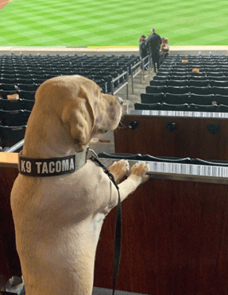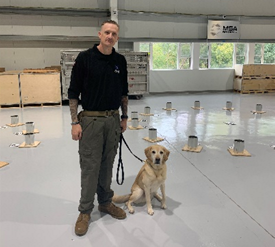Man’s best friend is a dedicated and lovable companion for so many, but their unique capabilities also make them a powerful asset across many functions. At MSA Security®, An Allied Universal® Company, we know the incredible value canines bring to detecting explosives and firearms. With a sense of smell estimated to be at least 10,000 times more sensitive than that of a human, dogs are skillful scent detectives. There are six million olfactory receptors in our human noses. Dogs have a whopping 300 million! Because a much larger portion of their brains is dedicated to analyzing scents, they can uniquely pick up odors at the molecular level. The difference is between smelling spaghetti sauce cooking on the stove and separately smelling the tomatoes, onions, garlic and individual herb ingredients that make up the sauce.
Dogs in the Workforce
Detection canines have a long history of helping humans track what we are unable to see or  sense. Today, with proper imprintation and training, canines are put to work finding just about anything – from explosives and firearms to missing people to polychlorinated biphenyls (PCBs) to disease and viruses. MSA Security currently has more than 850 single-purpose, single-handler Canine Detection Teams deployed internationally to sniff out the threat of homemade explosives (HMEs), firearms, narcotics or technical devices like lithium batteries. They are at work in the places we all go every day, including sports and entertainment venues, transportation hubs, landmarks, and commercial real estate buildings. And do not let their tail-wagging temperament and puppy-dog eyes fool you – while on the job, detection dogs like MSA’s Tacoma are always on patrol for the bad guys. At the same time, they create a welcoming environment for employees and guests.
sense. Today, with proper imprintation and training, canines are put to work finding just about anything – from explosives and firearms to missing people to polychlorinated biphenyls (PCBs) to disease and viruses. MSA Security currently has more than 850 single-purpose, single-handler Canine Detection Teams deployed internationally to sniff out the threat of homemade explosives (HMEs), firearms, narcotics or technical devices like lithium batteries. They are at work in the places we all go every day, including sports and entertainment venues, transportation hubs, landmarks, and commercial real estate buildings. And do not let their tail-wagging temperament and puppy-dog eyes fool you – while on the job, detection dogs like MSA’s Tacoma are always on patrol for the bad guys. At the same time, they create a welcoming environment for employees and guests.
Proven Specificity Training
 Detection canines are carefully hand-selected from sporting and hunting breeds for personality, intelligence and drive. This rigorous vetting is the first step in MSA’s proven six-phase training philosophy and relies on a significant level of existing socialization within the dog, which accelerates the training process and yields better results.
Detection canines are carefully hand-selected from sporting and hunting breeds for personality, intelligence and drive. This rigorous vetting is the first step in MSA’s proven six-phase training philosophy and relies on a significant level of existing socialization within the dog, which accelerates the training process and yields better results.

Phases two through four in MSA’s Training Program focus on the dog’s intended job. After a hearty breakfast and power walk, where will a power pup and their dedicated handler be headed for a day’s work? That specificity is key for the training that is customized and delivered at one of MSA’s national training academies. MSA Firearms Detection Canine Teams, as one example, are trained explicitly to effectively address the active shooter threat that is on the rise in public areas like schools, shopping centers and other gathering spaces. Different than any other deployment, these canines are imprinted to detect low-explosive powders, as well as cleaning solvents and other unique odors which enable them to indicate on all firearms, whether previously fired or static.
German Shepherd Rocco is one of those dogs. He has quickly become a welcomed furry friend for shoppers of all ages at a three-story shopping mall in Greensboro, North Carolina, where he and his handler report for duty every day. In this video, the duo demonstrates the firearms detection technique that helps mitigate risk to people and property. More now than ever before, security professionals recognize that these teams are an incredibly effective, versatile and dynamic added layer to a comprehensive security plan, aiding in the deterrence and detection of a concealed firearm.
|
Learn more about MSA Firearms Detection Canines. To meet more of MSA’s Explosive and Firearms Detection Canine Teams, and for timely content from MSA’s subject matter experts, be sure to subscribe to our blog. |
